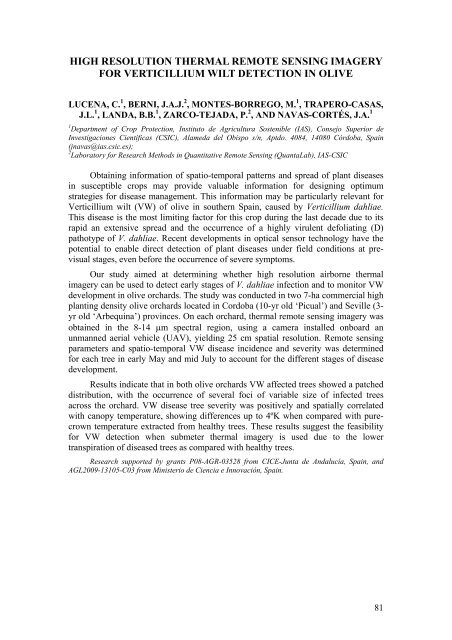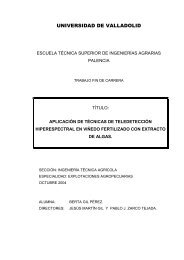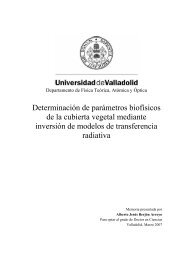10th INTERNATIONAL VERTICILLIUM SYMPOSIUM 16-20 ...
10th INTERNATIONAL VERTICILLIUM SYMPOSIUM 16-20 ...
10th INTERNATIONAL VERTICILLIUM SYMPOSIUM 16-20 ...
You also want an ePaper? Increase the reach of your titles
YUMPU automatically turns print PDFs into web optimized ePapers that Google loves.
HIGH RESOLUTION THERMAL REMOTE SENSING IMAGERYFOR <strong>VERTICILLIUM</strong> WILT DETECTION IN OLIVELUCENA, C. 1 , BERNI, J.A.J. 2 , MONTES-BORREGO, M. 1 , TRAPERO-CASAS,J.L. 1 , LANDA, B.B. 1 , ZARCO-TEJADA, P. 2 , AND NAVAS-CORTÉS, J.A. 11 Department of Crop Protection, Instituto de Agricultura Sostenible (IAS), Consejo Superior deInvestigaciones Científicas (CSIC), Alameda del Obispo s/n, Aptdo. 4084, 14080 Córdoba, Spain(jnavas@ias.csic.es);2 Laboratory for Research Methods in Quantitative Remote Sensing (QuantaLab), IAS-CSICObtaining information of spatio-temporal patterns and spread of plant diseasesin susceptible crops may provide valuable information for designing optimumstrategies for disease management. This information may be particularly relevant forVerticillium wilt (VW) of olive in southern Spain, caused by Verticillium dahliae.This disease is the most limiting factor for this crop during the last decade due to itsrapid an extensive spread and the occurrence of a highly virulent defoliating (D)pathotype of V. dahliae. Recent developments in optical sensor technology have thepotential to enable direct detection of plant diseases under field conditions at previsualstages, even before the occurrence of severe symptoms.Our study aimed at determining whether high resolution airborne thermalimagery can be used to detect early stages of V. dahliae infection and to monitor VWdevelopment in olive orchards. The study was conducted in two 7-ha commercial highplanting density olive orchards located in Cordoba (10-yr old ‘Picual’) and Seville (3-yr old ‘Arbequina’) provinces. On each orchard, thermal remote sensing imagery wasobtained in the 8-14 μm spectral region, using a camera installed onboard anunmanned aerial vehicle (UAV), yielding 25 cm spatial resolution. Remote sensingparameters and spatio-temporal VW disease incidence and severity was determinedfor each tree in early May and mid July to account for the different stages of diseasedevelopment.Results indicate that in both olive orchards VW affected trees showed a patcheddistribution, with the occurrence of several foci of variable size of infected treesacross the orchard. VW disease tree severity was positively and spatially correlatedwith canopy temperature, showing differences up to 4ºK when compared with purecrowntemperature extracted from healthy trees. These results suggest the feasibilityfor VW detection when submeter thermal imagery is used due to the lowertranspiration of diseased trees as compared with healthy trees.Research supported by grants P08-AGR-03528 from CICE-Junta de Andalucía, Spain, andAGL<strong>20</strong>09-13105-C03 from Ministerio de Ciencia e Innovación, Spain.81




